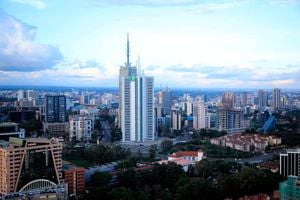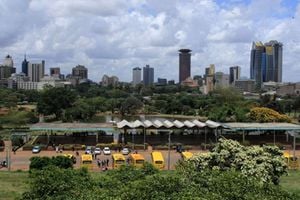
Marsabit Governor Mohamed Mohamud Ali.
Kenya’s largest county, Marsabit, recorded the fastest economic growth in 2023 at 9.3 per cent, in an economic ranking that also saw giants such as Nairobi and Nakuru post impressive performances and cementing their place as magnets for investment.
Marsabit County reaped the benefits of increased activities in the water and construction sectors according to the latest Gross County Product (GCP) report, which measures how wealth is distributed among the 47 devolved units. GCP is to the county what Gross Domestic Product (GDP) is to the country.
The GCP reports—produced by the Kenya National Bureau of Statistics (KNBS)—provide a monetary measure of the net market value of all the final goods and services produced within each of the counties.
Tana River, which like Marsabit does not feature among the country’s richest counties, had the second fastest growth at 7.6 per cent, an indicator that the growth for the two counties might have been due to their GCP coming from a low base.
The GCP report shows that Nakuru—the third richest county behind Nairobi and Kiambu over a five-year period—had the third fastest growth, capitalising on improved agricultural activities, which nearly doubled in the review period compared to 2022.
“Fifteen counties recorded economic growth of at least 5.0 per cent, with Marsabit leading at 9.3 per cent. Twenty-seven counties recorded growth of at least three (3.0) per cent but below five (5.0) per cent, while the remaining five counties had growth rates below three (3.0) per cent,” said KNBS in the report which was released yesterday.
Kenya’s richest county, Nairobi, posted the fifth biggest growth of 6.1 per cent, buoyed by improved performance of the financial sector, which takes up the largest share of the city’s GCP.
But there were also laggards, with several counties posting lower growth than the national average, which means their governors have their jobs cut out for them.
Embu recorded the slowest growth rate at 0.9 per cent. Elgeyo-Marakwet grew by 1.2 per cent, Nyamira (1.9 per cent), Bungoma (2.1 per cent) and Kisii (2.8 per cent), a performance that also points to little or no development projects in these counties.
Restricted development
These growth rates were lower than the national average of 4.6 per cent.
The GCP is proving to be a reliable barometer for the socio-economic performance of the 47 counties since the introduction of devolution by the new Constitution 14 years ago.
After years of restricted development—where power and resources were concentrated in Nairobi and sometimes given at the discretion of the Central government—Kenya sought to cascade economic opportunities to the grassroots by creating 47 devolved units.
However, as the 2024 Gross County Product (GCP) Report, the fourth in a series of reports produced in 2019, 2021, and 2023, shows, it has been a mixed performance.
Nairobi continues to dominate the Kenyan economy, with a share of close to a third of the total GCP.
Similarly, counties surrounding Nairobi such as Kiambu and Machakos have benefited from their proximity to the capital city’s massive market, with the country having a population of 4,750,056 by the end of 2023.
The GCP report shows that in the five-year average to 2023, Kiambu has the second largest share of the economy at 5.6 percent, followed by Nakuru with a contribution of 5.2 percent. In 2023 alone, however, Nakuru’s share (5.7 percent) was bigger than Kiambu’s 5.5 percent.
The report notes significant economic disparities, with the majority of counties (33) contributing less than two percent each to the national cake.
Although most Kenyans grow crops and keep livestock as their mainstay, commercial hubs such as Nairobi City, Kiambu, Mombasa, Nakuru, and Machakos, have higher GCP compared to the predominantly rural counties.
“Nonetheless, counties with diverse economic activities, especially in agriculture, like Meru, Kakamega, and Nyeri, also made significant contributions to the GVA (Gross Value Added),” said KNBS.
Counties that have reaped the benefit of agriculture are those that grow tea, maize, potatoes, and vegetables.
The population is turning into a major catalyst for economic activities. Counties with larger populations, in addition to having urban settings and diverse economic activities, contribute more to the overall GVA.
Open far-flung areas
“These counties include Nairobi City, Kiambu, Nakuru, and several others with substantial populations.”
There have been attempts to breathe life into parts of the country that had been locked from the economy. Successive governments have sought to open up the far-flung areas by building roads, ports and railways, and energy projects.
Additionally, the government has also laid fibre optic cables, connected homes to piped water, and built more schools to improve the standard of living in what was once described as ‘remote areas.’
Besides allocations for recurrent spending on salaries, travel, and entertainment, counties have also been given funds for development to help them grow their economies.
However, the County Government Budget Implementation Review Report for the financial year ending June 2024, recently by Controller of Budget Margarate Nyakang’o shows that 10 counties spent nothing on development projects.
In that period, counties spent a total of Sh6.71 billion, or just three percent of the annual budget of Sh205.33 billion, against a legal threshold of at least 30 per -cent.












